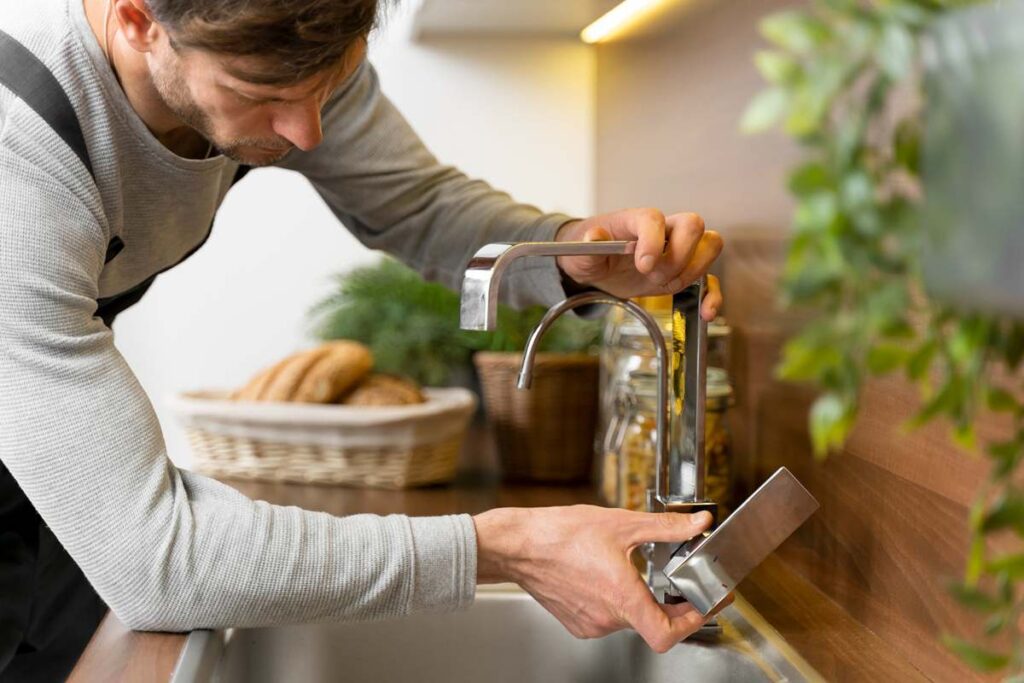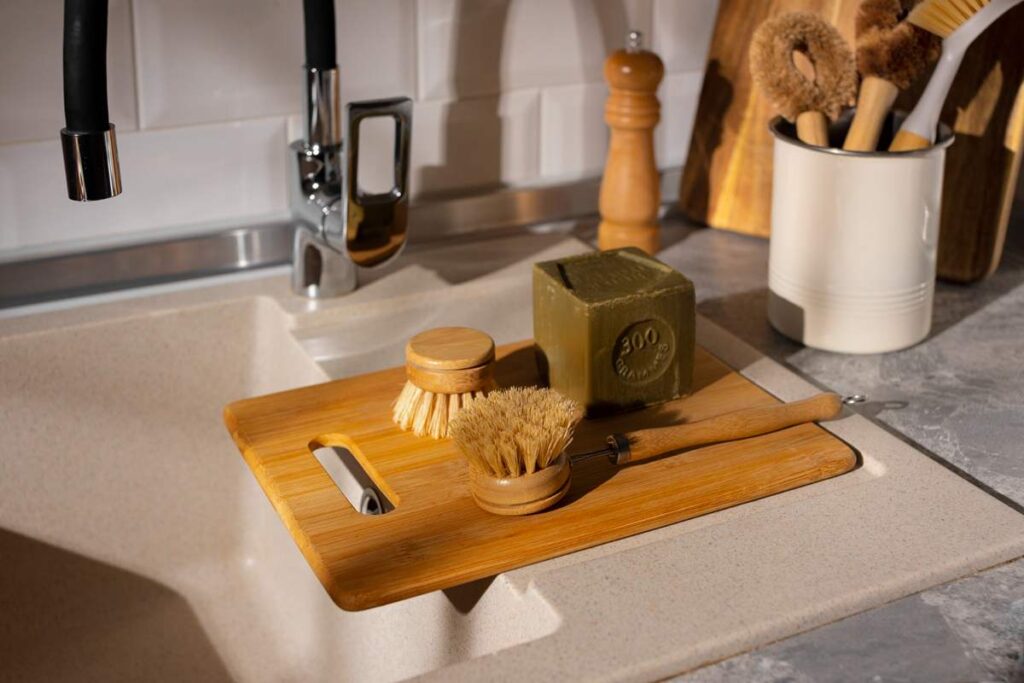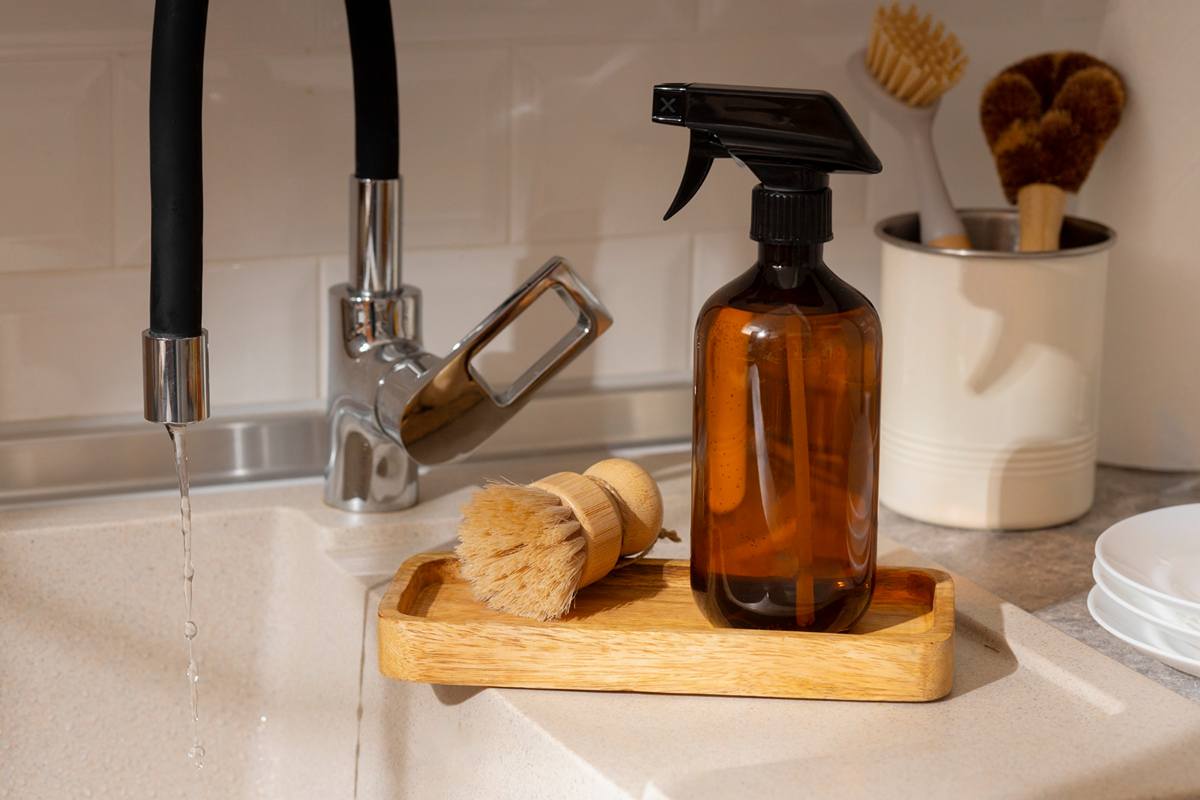Copper sinks add timeless beauty and charm to any kitchen or bathroom. Their warm tones and natural patina make each one unique, but they also need gentle care to stay shiny and last long. If you’re wondering how to clean a copper sink without damaging it, you’re in the right place. This guide will show you an easy, step-by-step method using safe, natural items you already have at home. Whether your sink is smooth or hammered, we’ll cover it all—plus share expert tips most guides skip. Let’s make your copper sink sparkle like new, the right and safe way.
What Makes Copper Sinks Unique?
Copper sinks aren’t just beautiful—they’re naturally smart, too. Copper is a living metal, which means it changes over time. As it reacts with air, water, and even the oils from your hands, it develops a darker finish called a patina. This patina protects the sink and gives it a warm, rustic look that gets better with age.
One of copper’s superpowers is that it has antimicrobial properties. That means it can kill many types of harmful bacteria on its own, making your sink more hygienic than other materials.
Because copper is a reactive surface, it responds quickly to different substances. Acids, harsh cleaners, and even toothpaste can leave spots or remove the protective patina. That’s why regular, gentle cleaning is so important—not just for keeping it beautiful, but also for keeping your kitchen or bathroom healthier.
How to Clean Copper Sinks Naturally
Keeping your copper sink clean doesn’t require expensive products or harsh chemicals. In fact, the best way to care for it is with natural, gentle ingredients that are probably already in your kitchen. Below is a simple method that works for both smooth and hammered copper sinks—perfect for anyone learning how to clean a copper sink the safe way.
What You’ll Need (Natural Tools)
Gather these basic supplies before you begin:
- Soft sponge (non-abrasive)
- Mild dish soap (gentle formula, no bleach)
- Lemon juice or vinegar (natural acid to clean and shine)
- Salt (works as a mild scrub)
- Warm water
Step-by-Step Cleaning Method
Follow this easy method to clean your copper sink naturally:
- Rinse the sink with warm water to remove food bits or soap residue.
- Apply a few drops of mild dish soap to your sponge. Gently scrub the entire surface.
- Rinse again with warm water to wash away the soap.
- Dry completely with a soft cloth to avoid water spots or mineral marks.
- For stubborn stains or spots:
- Mix lemon juice with salt to make a paste.
- Rub it gently on the stained area using a soft cloth or sponge.
- Rinse and dry well.
- Mix lemon juice with salt to make a paste.
How to Clean a Copper Sink with Baking Soda

Many people wonder if baking soda is safe for copper. The short answer? Yes, but only when used carefully. If your sink has stubborn spots that natural soap can’t remove, baking soda can be a gentle solution—as long as you don’t scrub too hard.
Safe or Not?
Baking soda is a mild cleaner that can help lift stains without using harsh chemicals. It’s safe for copper sinks when:
- You use it occasionally, not daily.
- You apply it gently, using a soft cloth or sponge.
- The sink has tough stains that lemon or vinegar can’t remove.
Quick Baking Soda Cleaning Steps
Here’s how to safely clean a copper sink using baking soda:
- Mix a small amount of baking soda with warm water to make a soft paste.
- Dip a soft sponge or cloth into the paste.
- Gently apply it to stained or greasy areas.
- Rinse thoroughly with clean, warm water.
- Dry the sink completely with a soft towel to prevent water marks.
How to Clean a Hammered Copper Sink

Hammered copper sinks have a stunning texture that adds extra character to any kitchen or bathroom. However, this unique feature also means that hammered copper sinks require some special care during cleaning. Follow the steps below to keep your sink looking beautiful without damaging its textured surface.
Why Hammered Sinks Need Special Care
Hammered copper sinks are textured, which means they can hold onto more grime, food particles, and soap scum. While this adds a rustic charm, it also means you’ll need to clean them a bit differently from a smooth copper sink.
Important to Note:
- Scrubbing too hard can damage the finish or even remove parts of the hammered texture.
- The crevices can trap dirt, so gentle care is essential to avoid scratching or altering the unique appearance.
Cleaning Process
Here’s how to clean a hammered copper sink properly:
- Use a soft cloth to wipe down the sink, especially in the grooves, where dirt can collect.
- For stubborn buildup, mix lemon juice and salt to form a paste, then apply it gently to the areas needing extra attention.
- Avoid using scrubbing brushes or rough sponges, as they can damage the delicate hammered texture and cause unsightly scratches.
What to Avoid When Cleaning Copper Sinks
While copper sinks are durable, they do require careful handling to maintain their beauty. To keep your sink looking its best, avoid these common mistakes:
Harsh chemicals like bleach or ammonia—they can strip away the patina and damage the surface.
Abrasive tools such as steel wool or scrub brushes—these can scratch the copper and remove its natural shine.
Leaving dirty dishes or acidic foods (like tomatoes or citrus) in the sink for long periods—these can cause stains or tarnish the copper surface.
Using rough sponges—even sponges that feel soft can be too abrasive for copper if used too aggressively.
How to Maintain Your Copper Sink Daily
Keeping your copper sink in top shape requires just a few simple habits. Regular maintenance will not only preserve its beauty but also extend its life.
- Wipe it after every use: Use a soft cloth to wipe down your sink after each use to remove water spots and soap residue.
- Dry to avoid spots: Always dry your sink thoroughly with a soft towel to prevent water spots from forming.
- Wax once a month (optional): For extra shine and to help protect the patina, you can apply a copper-friendly wax once a month. This helps seal the surface and keeps your sink looking shiny.
Maintenance Schedule
| Task | Frequency |
| Wipe & Dry | Daily |
| Natural Clean | Weekly |
| Wax Coating | Monthly (optional) |
Extra Tips Most People Miss
When it comes to maintaining your copper sink, a few extra steps can help preserve its beauty and extend its life. Here are some pro tips that many people miss, but you shouldn’t!
- Use beeswax or carnauba wax for extra shine: These natural waxes not only add a beautiful shine but also protect the copper surface. They are safe and eco-friendly alternatives to chemical cleaners.
- Install a sink grid: To prevent scratches from pots, pans, or heavy dishes, consider adding a sink grid. It acts as a protective barrier and helps avoid damage to the surface.
- Patina is not a stain: Over time, copper naturally develops a greenish or darkened patina. This is a sign of the metal’s natural aging process and is completely normal. It’s not a stain but a characteristic of copper that many people love for its vintage, rustic look.
- Hard water effects: Hard water can leave behind mineral deposits and stains on your copper sink. To deal with this, you can regularly clean your sink with a vinegar-water solution to remove buildup, followed by drying to avoid water spots.
Why Trust This Guide?
We understand how important it is to maintain the beauty and functionality of your copper sink, and that’s why this guide is designed to provide you with the most reliable and trustworthy information. Here’s why you can trust this guide:
- Real Copper Sink Owners’ Experiences: This guide is based on the experiences of actual copper sink owners, providing insights from people who’ve handled these sinks daily and know what works best.
- Written with Input from Home Maintenance Experts: We’ve consulted home maintenance professionals who specialize in copper care to ensure that the cleaning and maintenance tips are both safe and effective for your sink.
- Links to Trusted Sources: To further build trust, we’ve referenced authoritative and respected sources like Better Homes & Gardens, Sinkology, and Elkay, ensuring that the advice you’re getting comes from reputable experts in the industry.
FAQs
How can I make my copper sink look new again?
To make your copper sink look new again, gently clean it using natural ingredients like lemon juice and salt. You can also apply a copper-friendly wax to restore its shine and protect the surface from further tarnishing.
What’s the best cleaner for copper sinks?
The best cleaner for copper sinks is a mild dish soap mixed with warm water. For tougher stains, a lemon and salt paste works wonders. Avoid using harsh chemicals to preserve the sink’s patina and natural finish.
Can you use vinegar on copper sinks?
Yes, vinegar can be used to clean copper sinks, but it should be diluted with water. Vinegar helps to remove mineral deposits but should be used sparingly to avoid damaging the finish.
What is the best thing to clean copper?
The best way to clean copper is to use natural solutions like a mixture of lemon juice, salt, or mild dish soap. These options are gentle and won’t strip away the protective patina layer.
How often should I clean my copper sink?
You should clean your copper sink at least once a week to maintain its shine. Daily drying after use will help prevent water spots and stains from forming.
Can I remove tarnish from copper naturally?
Yes, you can remove tarnish naturally using a mixture of lemon and salt. Gently rub the paste onto the tarnished area, then rinse and dry with a soft cloth for best results.
Is it safe to use baking soda on copper sinks?
Baking soda can be used on copper sinks for tough stains, but it should be applied gently. Avoid scrubbing too hard as it can be abrasive and may scratch the surface.
Conclusion
Taking care of your copper sink doesn’t have to be difficult or time-consuming. With just a few simple steps, you can keep your sink looking shiny and beautiful for years. Remember, it’s all about drying daily, cleaning weekly, and applying a wax coating monthly (optional) to maintain its natural beauty.
By following the natural methods shared in this guide, you’ll be able to maintain your sink without harsh chemicals, ensuring it stays in top shape for years to come.










